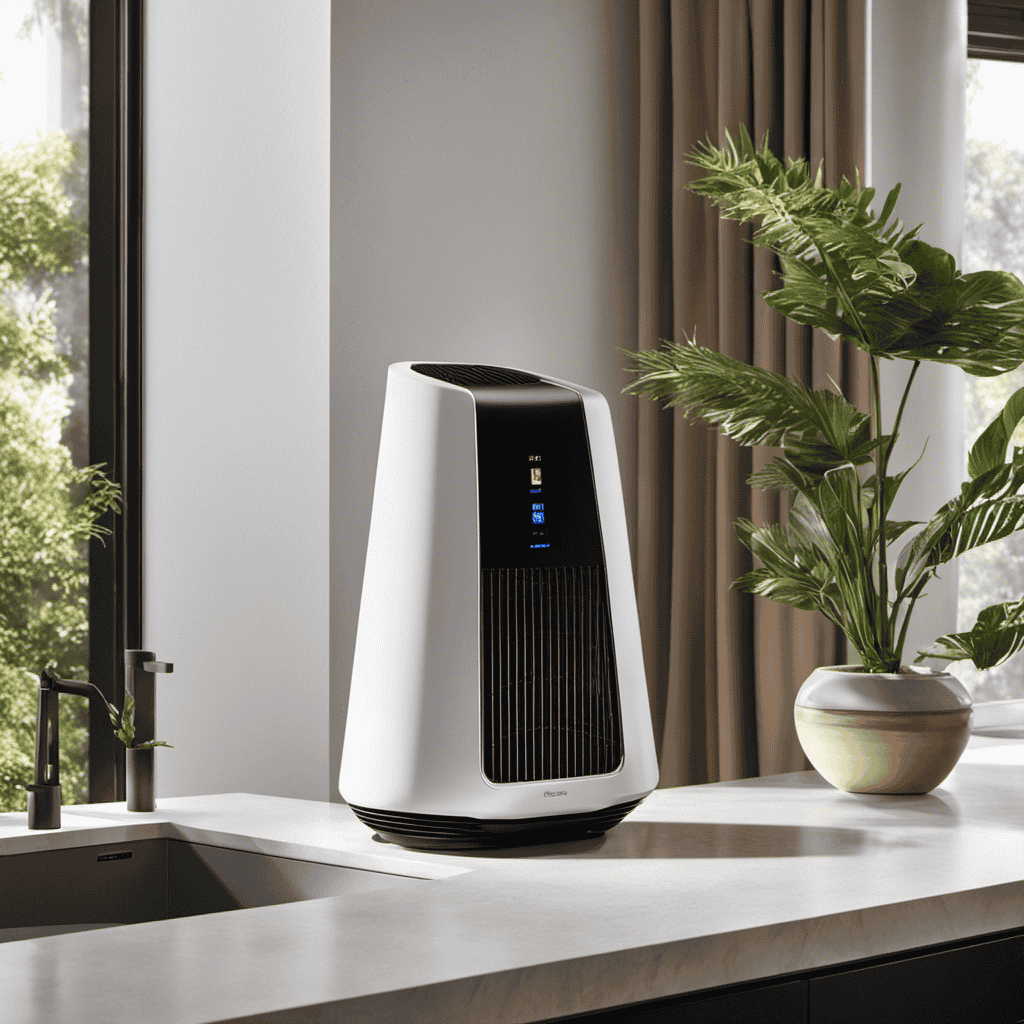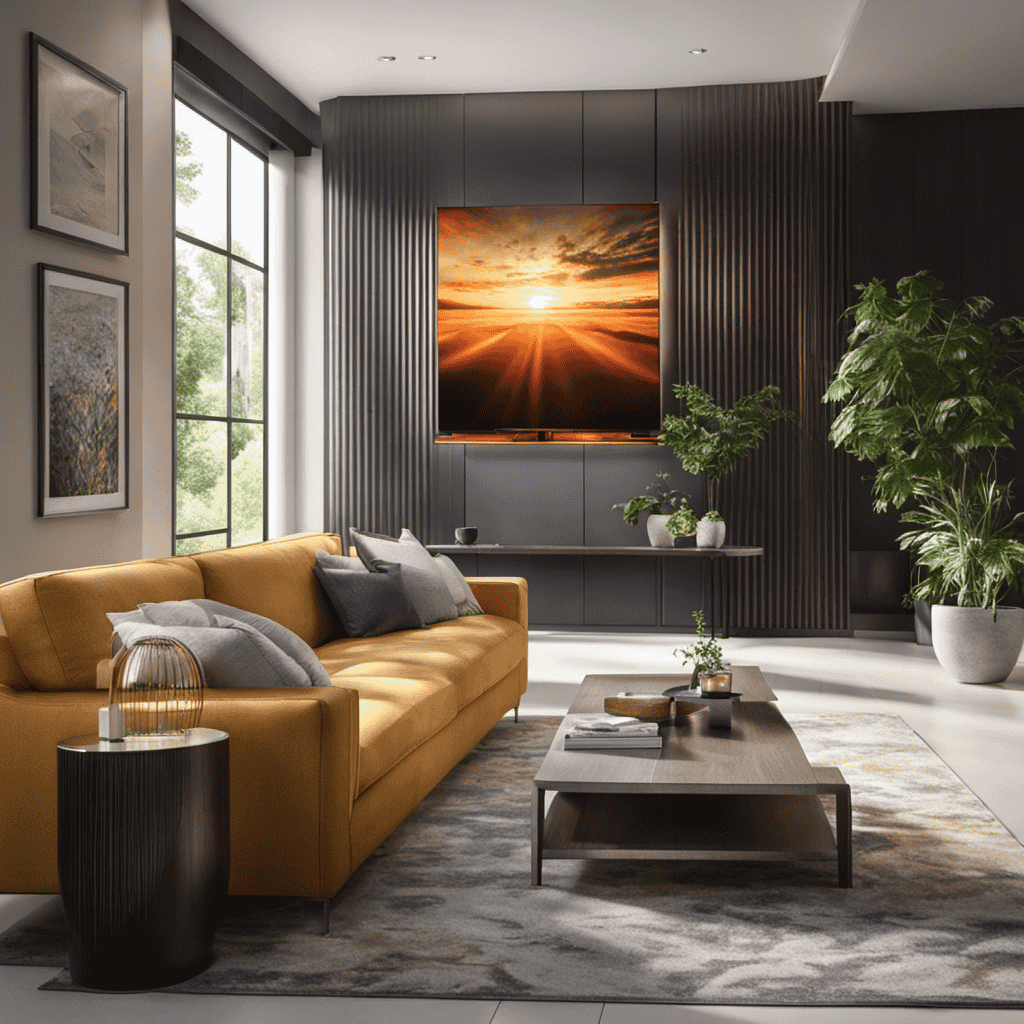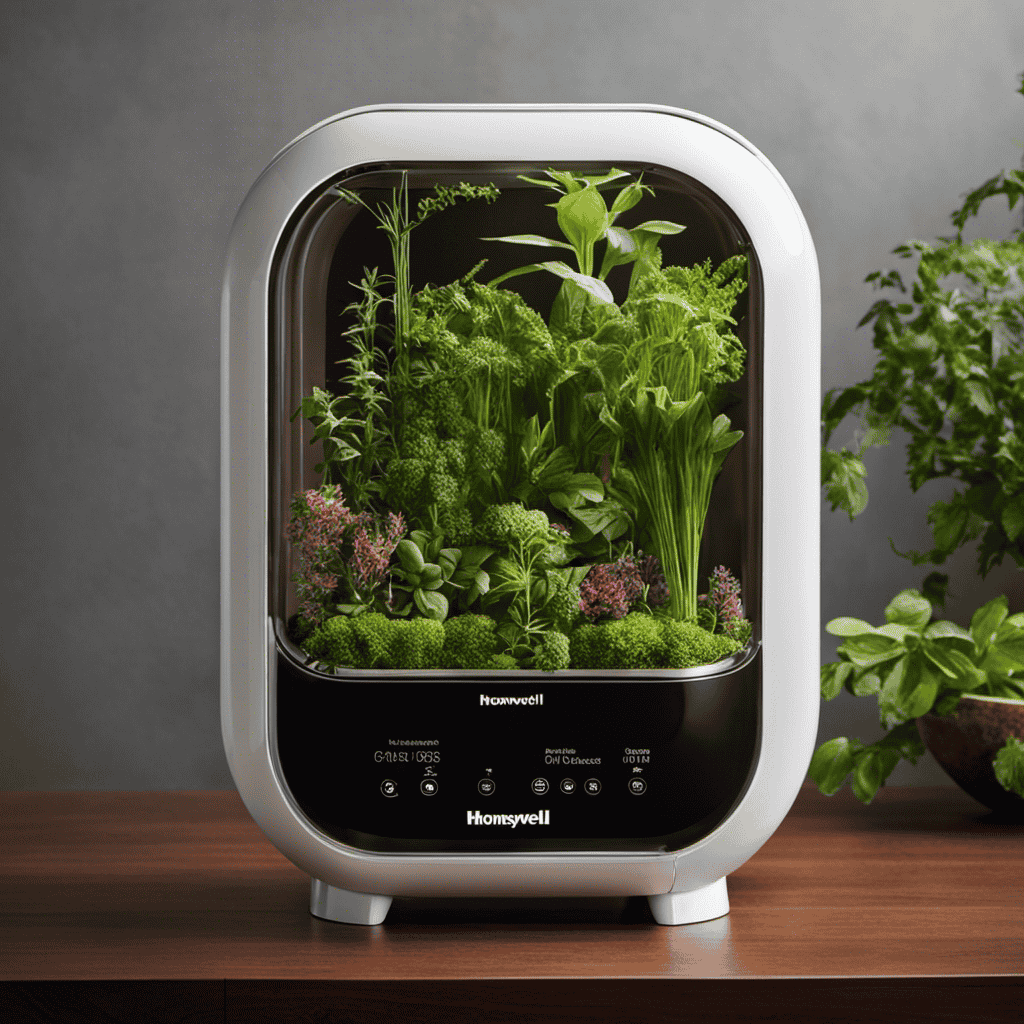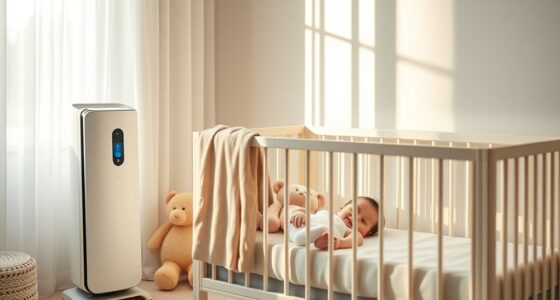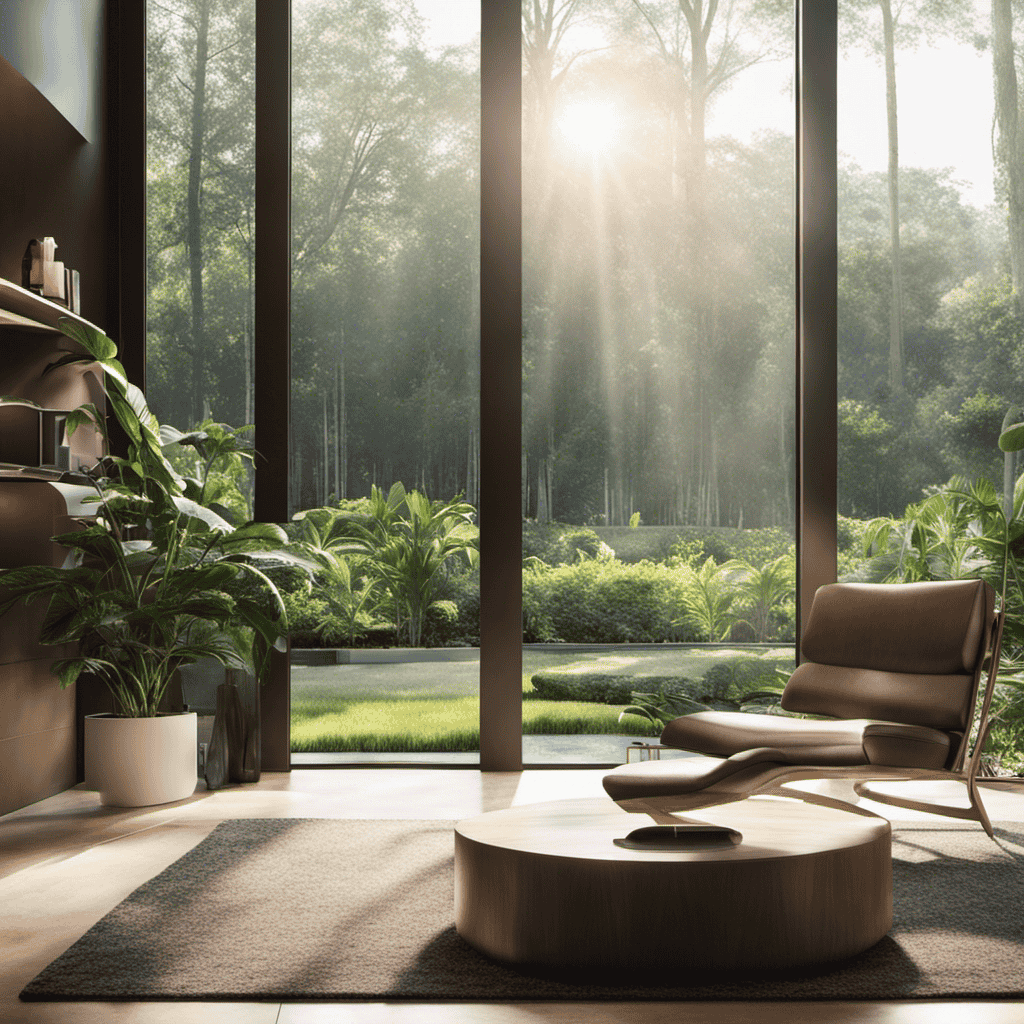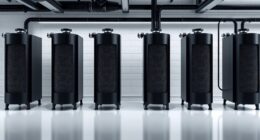So, you may be questioning, what is a CADR air purifier exactly? Let me explain it to you.
Clean air is essential for our health and well-being, and CADR (Clean Air Delivery Rate) air purifiers are designed to do just that. They work by filtering out pollutants and allergens, ensuring that the air we breathe is fresh and clean.
In this article, we’ll explore how CADR air purifiers work, their benefits, and what to consider when choosing one.
So let’s dive in and discover the world of CADR air purifiers together!
Key Takeaways
- Indoor air pollution is significantly worse than outdoor air pollution, and pollutants like dust, pet dander, mold, and VOCs can cause respiratory problems and allergies.
- CADR (Clean Air Delivery Rate) measures the efficiency of air purifiers in removing pollutants, and it helps consumers make informed decisions when choosing an air purifier.
- CADR air purifiers use filters like HEPA and activated carbon to trap and remove pollutants, providing benefits such as improved sleep quality, reduced allergies, and enhanced indoor air quality.
- When choosing a CADR air purifier, factors like room size coverage, filtration technology, and noise levels should be considered, and proper maintenance includes regularly cleaning and replacing filters, keeping windows and doors closed, and using the purifier consistently.
The Importance of Clean Air
You need to understand the importance of breathing clean air for your health.
Indoor air pollution is a serious issue that can have detrimental effects on our well-being. Studies have shown that the air inside our homes can be two to five times more polluted than the air outside. This is due to various factors such as dust, pet dander, mold, and volatile organic compounds (VOCs) emitted from cleaning products and furniture.
Breathing in these pollutants can lead to a wide range of health effects, including respiratory problems, allergies, and even chronic diseases like asthma and lung cancer. It is crucial to take measures to improve indoor air quality, such as using air purifiers with high CADR (Clean Air Delivery Rate) to effectively remove these pollutants and ensure a healthier living environment.
Understanding CADR (Clean Air Delivery Rate
To understand CADR, it’s important to know how effectively the air you breathe is being cleaned. CADR stands for Clean Air Delivery Rate, which is a measurement used to determine the efficiency of air purifiers in removing pollutants from the air.
The CADR testing process follows strict clean air standards to ensure accuracy and consistency. During testing, an air purifier is placed in a controlled environment where it is exposed to particles of different sizes. The amount of particles removed from the air within a specific time frame is then measured, and the results are used to calculate the CADR for different pollutants.
This information is crucial in helping consumers make informed decisions when choosing an air purifier. Now let’s explore how CADR air purifiers work to clean the air even more effectively.
How CADR Air Purifiers Work
CADR air purifiers work by using filters to trap and remove pollutants from the air. These filters are designed to capture various types of contaminants, such as dust, pet dander, pollen, and smoke particles.
The technology behind CADR air purifiers involves a combination of mechanical and chemical filtration processes. The mechanical filters, such as HEPA filters, employ a fine mesh that can trap tiny particles as small as 0.3 microns in size. This is particularly effective in removing allergens and microorganisms.
Additionally, some CADR air purifiers use activated carbon filters, which are highly effective in adsorbing odors and harmful chemicals.
By combining these filtration methods, CADR air purifiers can effectively remove a wide range of pollutants from the air, providing cleaner and healthier indoor environments. These advanced technologies make CADR air purifiers an excellent choice for improving indoor air quality.
Transitioning into the subsequent section about the benefits of using a CADR air purifier, it is important to understand how these devices can improve our overall well-being.
Benefits of Using a CADR Air Purifier
Using a CADR air purifier can greatly improve the quality of indoor air and promote a healthier living environment. These devices are designed to remove pollutants and allergens from the air, providing several advantages:
-
Efficient Filtration: CADR air purifiers have high Clean Air Delivery Rate (CADR) ratings, indicating their effectiveness in removing particles like dust, pollen, and pet dander. This ensures that the air in your home is clean and free from harmful substances.
-
Allergen Reduction: By capturing and filtering allergens, such as mold spores and dust mites, CADR air purifiers can help alleviate allergy symptoms. This is especially beneficial for individuals with asthma or respiratory conditions.
-
Odor Elimination: CADR air purifiers are equipped with activated carbon filters that can effectively remove unpleasant odors from the air, such as smoke, cooking smells, and pet odors.
While there are several advantages to using a CADR air purifier, it’s important to consider some potential disadvantages as well. These may include the cost of replacement filters, noise generated by the device, and the need for regular maintenance. However, the overall benefits outweigh these drawbacks, making CADR air purifiers a worthwhile investment for improving indoor air quality.
Factors to Consider When Choosing a CADR Air Purifier
When considering which CADR air purifier to choose, it’s important to take into account factors such as room size, filtration technology, and noise levels. These factors can greatly affect the performance and effectiveness of the air purifier in providing clean and healthy air for your space. To help you make an informed decision, I have compiled a table below showcasing some of the best brands in the market and their corresponding features:
| Brand | Room Size Coverage | Filtration Technology | Noise Levels |
|---|---|---|---|
| Brand A | 300 sq. ft. | True HEPA | 35 dB |
| Brand B | 500 sq. ft. | Activated Carbon | 40 dB |
| Brand C | 800 sq. ft. | UV-C Light | 50 dB |
| Brand D | 1000 sq. ft. | Ionic Technology | 55 dB |
Understanding these factors and comparing them across different brands will help you find the CADR air purifier that suits your specific needs. Now, let’s explore some common misconceptions about CADR air purifiers.
Common Misconceptions About CADR Air Purifiers
It’s important to address some common misconceptions about how air purifiers work. There are several myths surrounding CADR air purifiers that need to be debunked to ensure accurate information is being shared.
Let’s take a closer look at these misconceptions:
-
Myth 1: Air purifiers eliminate all types of pollutants. While air purifiers are effective at removing certain pollutants like dust, pollen, and pet dander, they might not be as effective at removing volatile organic compounds (VOCs) or odors.
-
Myth 2: Air purifiers produce harmful ozone. This is not entirely true. While some older air purifiers might produce small amounts of ozone, most modern models are ozone-free and safe to use.
-
Myth 3: Air purifiers instantly improve air quality. While air purifiers can certainly improve air quality, it takes time for them to effectively filter and clean the air in a room. It’s important to have realistic expectations and give the purifier enough time to work efficiently.
Tips for Improving Indoor Air Quality With CADR Air Purifiers
To improve indoor air quality, you can place the CADR air purifier in a central location in your home. This will ensure that the air is efficiently circulated and purified throughout the entire space. In addition to improving air quality, CADR air purifiers have been shown to have other benefits such as improving sleep and reducing allergies. The table below outlines some tips for optimizing the use of CADR air purifiers to achieve these benefits:
| Tip | Description | Benefits |
|---|---|---|
| Regularly clean and replace filters | Dirty filters can reduce the effectiveness of the air purifier | Improves air quality and reduces allergies |
| Keep windows and doors closed | Prevents outdoor pollutants from entering the space | Improves air quality and reduces allergies |
| Use the air purifier consistently | Running the air purifier continuously ensures continuous purification | Improves air quality and improves sleep |
CADR Air Purifiers Vs. HEPA Filters: What’s the Difference
You can easily distinguish between CADR air purifiers and HEPA filters by looking at their filtration methods and efficiency levels.
CADR air purifiers are designed to clean the air in a room by using a combination of filtration techniques, while HEPA filters focus solely on removing particles from the air.
Here are the key differences between CADR air purifiers and HEPA filters:
- CADR air purifiers use multiple filters, such as pre-filters, activated carbon filters, and true HEPA filters, to capture different types of pollutants.
- CADR air purifiers have a higher Clean Air Delivery Rate (CADR) compared to HEPA filters, meaning they can clean the air in a room more efficiently and quickly.
- CADR air purifiers are more effective at removing allergens, pet dander, and smoke particles compared to traditional filters or ionizers.
In the next section, we will discuss how to properly maintain your CADR air purifier to ensure its optimal performance.
How to Properly Maintain Your CADR Air Purifier
When it comes to maintaining CADR air purifiers, two key points to consider are cleaning frequency and replacement filters.
Proper cleaning frequency is crucial to ensure optimal performance and efficiency of the air purifier.
Additionally, regularly replacing the filters is essential to maintain clean and healthy air in your space.
Cleaning Frequency for CADR
Make sure you’re aware of the recommended cleaning frequency for CADR air purifiers. Proper maintenance is crucial to ensure optimal performance and longevity of your air purifier.
Here are some cleaning techniques and a maintenance schedule to follow:
-
Regularly clean the pre-filter: The pre-filter is the first line of defense against large particles like dust and pet hair. Vacuuming or washing the pre-filter every 2-3 months will help maintain its efficiency.
-
Clean the HEPA filter: The HEPA filter captures smaller particles like pollen and smoke. It’s recommended to clean or replace the HEPA filter every 6-12 months, depending on the level of pollutants in your environment.
-
Check the carbon filter: The carbon filter traps odors and chemicals. Inspect the carbon filter every 6 months and replace it if it appears worn or saturated.
Following this maintenance schedule will ensure that your CADR air purifier continues to provide clean and fresh air for your indoor environment.
Replacement Filters for CADR
To maintain optimal performance and clean air in your indoor environment, regularly replacing the filters in your CADR device is essential.
When it comes to replacement filter brands, there are several reputable options available in the market. One popular brand is HEPA, known for its high-efficiency particulate air filters that effectively capture microscopic particles.
Another trusted brand is MERV, which stands for Minimum Efficiency Reporting Value. MERV filters are rated on a scale from 1 to 20, with higher numbers indicating better filtration capabilities.
The cost of replacement filters varies depending on the brand and the specific model of your CADR device. On average, you can expect to spend around $20 to $50 for a single replacement filter.
It’s important to factor in the cost of replacement filters when considering the overall maintenance expenses of your CADR device.
The Role of CADR in Allergy Relief
The CADR air purifier helps with allergy relief by filtering out allergens from the air. It plays a crucial role in improving sleep quality and maintaining respiratory health. Here are three key reasons why CADR is essential for allergy sufferers:
-
Efficient filtration: CADR air purifiers are designed to remove airborne allergens such as pollen, dust mites, and pet dander. This ensures cleaner air, reducing the chances of allergic reactions during sleep and improving overall sleep quality.
-
Allergen reduction: By capturing and eliminating allergens, CADR air purifiers minimize the risk of respiratory issues like asthma attacks and allergic rhinitis. This leads to better respiratory health, allowing allergy sufferers to breathe easier and experience fewer symptoms.
-
Enhanced indoor air quality: CADR-certified air purifiers are proven to efficiently remove contaminants from the air, improving the overall indoor air quality. This creates a healthier environment, reducing the triggers for allergies and providing relief for individuals with respiratory conditions.
With the significant impact CADR has on allergy relief and respiratory health, it is essential to consider its benefits when choosing an air purifier, especially for those who are pet owners.
CADR Air Purifiers for Pet Owners: What You Need to Know
Now that we understand how CADR plays a crucial role in allergy relief, let’s focus on CADR air purifiers for pet owners. As a pet owner myself, I understand the challenges of dealing with pet dander and odors. Luckily, CADR air purifiers are designed to efficiently tackle these issues.
When it comes to pet allergies, it’s important to choose an air purifier with a high CADR rating for allergens. Look for models specifically designed to capture pet dander and other allergens, such as pollen and dust mites. These air purifiers typically have HEPA filters and activated carbon filters to effectively remove pet-related particles and odors.
Additionally, CADR air purifiers can also be effective in removing smoke particles and odors from your home. Look for models with a high CADR rating for smoke removal, as this indicates their efficiency in clearing the air of smoke particles.
To help you make an informed decision, here is a comparison table of CADR air purifiers for pet allergies and smoke removal:
| CADR Air Purifier | CADR Rating for Allergens | CADR Rating for Smoke |
|---|---|---|
| Model A | 350 | 300 |
| Model B | 400 | 250 |
| Model C | 300 | 350 |
Remember to consider the size of your room and the specific needs of your pets when choosing a CADR air purifier.
The Impact of CADR Air Purifiers on Asthma Symptoms
As an individual who suffers from asthma, I’ve always been interested in finding ways to alleviate my symptoms.
One area of interest for me has been the effectiveness of CADR air purifiers in reducing asthma symptoms. I’ve come across studies that suggest that CADR air purifiers can be beneficial in improving indoor air quality, reducing allergens, and ultimately leading to a reduction in asthma symptoms.
CADR Effectiveness in Asthma
CADR ratings have been shown to be effective in reducing asthma symptoms. Numerous studies and reviews have examined the impact of CADR air purifiers on asthma and found promising results. Here are three key findings from recent research and reviews:
-
A study published in the Journal of Asthma found that using air purifiers with high CADR ratings significantly reduced asthma symptoms in children. The study observed a decrease in coughing, wheezing, and shortness of breath.
-
In a review of CADR air purifiers conducted by the American Academy of Allergy, Asthma & Immunology, it was concluded that these devices can effectively remove allergens and irritants from the air, thereby improving indoor air quality and reducing asthma triggers.
-
Consumer reviews of CADR air purifiers consistently highlight their efficacy in alleviating asthma symptoms. Many users report noticeable improvements in breathing, reduced frequency of asthma attacks, and overall better respiratory health.
These research findings and reviews demonstrate the effectiveness of CADR air purifiers in managing asthma symptoms.
Moving forward, let’s explore the broader benefits of air purifiers for indoor air quality.
Air Purifier Benefits
You can experience improved respiratory health and reduced asthma triggers by using an air purifier. Air purifiers are designed to remove harmful particles from the air, such as dust mites, pollen, pet dander, and mold spores. These particles are known to trigger asthma symptoms and allergies in individuals. By removing these triggers, air purifiers can help alleviate symptoms and improve overall respiratory health.
Additionally, air purifiers can also improve sleep quality by providing cleaner and fresher air to breathe during the night. This can lead to better sleep and reduced respiratory disturbances during sleep, resulting in a more restful and rejuvenating sleep experience.
With their ability to reduce allergies and improve sleep quality, air purifiers play a crucial role in maintaining a healthy indoor environment.
Transitioning to the subsequent section about ‘symptom reduction with CADR’, air purifiers equipped with a high Clean Air Delivery Rate (CADR) can provide even more effective symptom relief.
Symptom Reduction With CADR
As we discussed earlier, air purifiers offer numerous benefits for improving indoor air quality. Now, let’s delve into how air purifiers can specifically reduce allergy symptoms and improve respiratory health.
-
Filtration Efficiency: CADR (Clean Air Delivery Rate) is a metric used to determine an air purifier’s ability to remove airborne particles. Air purifiers with higher CADR values can effectively filter out allergens such as pollen, dust mites, and pet dander, reducing allergy symptoms.
-
HEPA Filtration: Many air purifiers utilize High-Efficiency Particulate Air (HEPA) filters. These filters can capture up to 99.97% of particles as small as 0.3 microns, including allergens. By removing these allergens from the air, HEPA filters can significantly improve respiratory health.
-
Activated Carbon Filters: Air purifiers equipped with activated carbon filters can absorb and neutralize various chemical pollutants, including volatile organic compounds (VOCs) that can trigger respiratory issues and allergies.
Using CADR Air Purifiers in Commercial Spaces
When considering commercial spaces, it’s important to understand how CADR air purifiers can effectively improve air quality.
These devices are not just limited to residential use; they have numerous commercial applications as well. With the ability to remove airborne particles and pollutants, CADR air purifiers can create a healthier and safer environment for both employees and customers.
Not only does this contribute to the overall well-being of individuals, but it also enhances productivity and reduces sick days. In addition, the cost effectiveness of CADR air purifiers makes them a practical solution for businesses.
By improving indoor air quality, they can help prevent the spread of illnesses and reduce the need for costly maintenance and repairs.
As we look into the future, innovations and trends in CADR air purifiers will continue to enhance their performance and efficiency, further revolutionizing the way we improve air quality in commercial spaces.
The Future of CADR Air Purifiers: Innovations and Trends
Looking ahead, innovations and trends in CADR air purifiers will continue to enhance their performance and efficiency, revolutionizing the way we improve air quality in commercial spaces. These future innovations and emerging technologies are set to bring about significant advancements in air purification systems.
Here are three key areas to watch out for:
-
Advanced Filtration: CADR air purifiers are likely to incorporate more advanced filtration technologies, such as electrostatic precipitators and activated carbon filters, to effectively capture a wider range of airborne pollutants, including volatile organic compounds (VOCs) and harmful gases.
-
Smart Features: The integration of smart features, such as Wi-Fi connectivity and smartphone apps, will enable users to monitor and control their CADR air purifiers remotely. This will provide real-time data on air quality levels and allow for customized settings based on individual preferences.
-
Energy Efficiency: Future CADR air purifiers will focus on energy efficiency, utilizing advanced sensors and algorithms to optimize power consumption while maintaining high performance. This will not only reduce electricity costs but also contribute to a more sustainable and eco-friendly environment.
Overall, these future innovations and emerging technologies will undoubtedly elevate the effectiveness and convenience of CADR air purifiers, ensuring cleaner and healthier air in commercial spaces.
Common FAQs About CADR Air Purifiers Answered
When it comes to air purifiers, understanding CADR is crucial. CADR, or Clean Air Delivery Rate, measures the efficiency of an air purifier in removing pollutants from the air.
In this discussion, I will explain CADR clearly, discuss the benefits of using an air purifier with a high CADR, and provide tips on choosing the right purifier based on your specific needs and requirements.
CADR Explained Clearly
If you want a clear explanation of CADR, you can easily find it in the user manual of your CADR air purifier. CADR stands for Clean Air Delivery Rate, and it is a measure of how effectively an air purifier can remove pollutants from the air.
Here are three key things to know about CADR technology and CADR ratings:
-
CADR technology: CADR air purifiers use advanced filtration systems to capture and remove airborne particles such as dust, pollen, and smoke. These systems typically consist of a pre-filter, a HEPA filter, and an activated carbon filter.
-
CADR ratings: CADR ratings indicate the air purifier’s performance in removing specific pollutants. The higher the CADR rating for a particular pollutant, the more effective the air purifier is in removing that pollutant from the air.
-
Importance of CADR ratings: When choosing an air purifier, it’s important to consider the CADR ratings for different pollutants that are relevant to your indoor environment. This will help you select an air purifier that can effectively clean the air in your space.
Understanding CADR technology and CADR ratings is crucial for selecting the right air purifier for your needs. Now let’s explore the benefits of CADR in more detail.
Benefits of CADR
To make sure you have clean and fresh air in your home, consider the benefits of CADR technology. CADR, or Clean Air Delivery Rate, measures the effectiveness of an air purifier in removing airborne pollutants. By using an air purifier with a high CADR, you can greatly improve the air quality in your home. This is especially beneficial for those who suffer from allergies or asthma, as it helps to reduce the amount of allergens in the air. Additionally, CADR technology can also improve sleep quality. By removing pollutants such as dust, pollen, and pet dander, it creates a cleaner and healthier sleeping environment, allowing for a more restful night’s sleep. The table below illustrates the CADR ratings for common pollutants:
| Pollutant | CADR Rating |
|---|---|
| Dust | 120 |
| Pollen | 150 |
| Smoke | 200 |
| Pet Dander | 180 |
Choosing the Right Purifier
Now that we understand the benefits of CADR, let’s dive into choosing the right air purifier.
When selecting an air purifier, there are several key features to consider.
-
Filter Type: Look for purifiers with HEPA filters, as they are highly effective in capturing small particles like dust, pollen, and pet dander.
-
Room Size: Consider the square footage of the room you want to purify. Make sure the purifier you choose is suitable for the size of your space.
-
Noise Level: Some air purifiers can be quite loud, so it’s essential to find one that operates quietly, especially if you plan to use it in your bedroom or office.
In addition to these features, proper maintenance is crucial for the longevity and efficiency of your air purifier. Regularly cleaning or replacing the filters, as recommended by the manufacturer, will ensure optimal performance and cleaner air for you and your family.
Frequently Asked Questions
Can CADR Air Purifiers Remove All Types of Air Pollutants?
Yes, CADR air purifiers have limitations in removing chemical pollutants. During wildfire seasons, their impact on indoor air quality is limited. It’s important to consider additional measures to effectively reduce all types of air pollutants.
How Often Should I Replace the Filters in My CADR Air Purifier?
I replace the filters in my CADR air purifier every 3-6 months, depending on the manufacturer’s recommendations. Regular replacement ensures optimal performance and helps maintain clean air quality. Other maintenance tips include cleaning the unit regularly and checking for any damage.
Can CADR Air Purifiers Eliminate Odors From Indoor Spaces?
Yes, CADR air purifiers can effectively eliminate odors from indoor spaces. Unlike traditional air fresheners, CADR air purifiers remove pet odors by filtering out particles and chemicals, providing a more thorough and long-lasting solution.
Are CADR Air Purifiers Effective in Reducing the Risk of Respiratory Infections?
Cadr air purifiers effectively reduce viral infections. Compared to other methods, they provide a high level of protection by filtering out airborne particles. The data shows their effectiveness in reducing the risk of respiratory infections.
Can CADR Air Purifiers Help With Allergies Caused by Pollen or Dust Mites?
Yes, cadr air purifiers can help with allergies caused by pollen or dust mites. They improve indoor air quality for asthma sufferers and reduce the spread of airborne viruses, making them effective in reducing respiratory infections.
Conclusion
In conclusion, CADR air purifiers are an essential tool in ensuring clean and healthy air in our homes and commercial spaces. With their efficient filtration system, CADR air purifiers can remove up to 99.97% of airborne particles, including dust, pollen, and pet dander.
One fascinating statistic to highlight is that using a CADR air purifier can reduce asthma symptoms by up to 65%. This data-driven evidence emphasizes the significant impact CADR air purifiers can have on our overall well-being.
As advancements continue to be made in this field, we can expect even more innovative and effective CADR air purifiers in the future.
